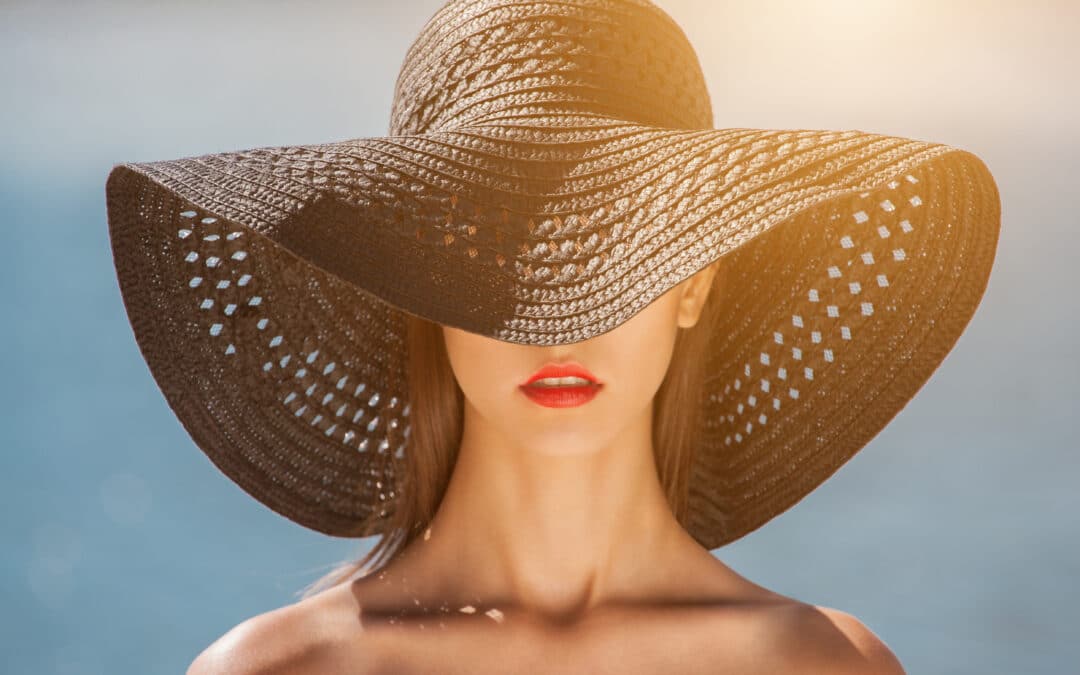My patients, friends and family know my mantra: There is no such thing as a safe tan!
A tan = injury to your skin by UVL
When you are exposed to the ultraviolet rays from the sun, or visit a tanning salon, your skin is damaged. Short term damage is a sunburn. Long term consequences of too much sun are wrinkles, freckles, photoaging as well as skin cancer.
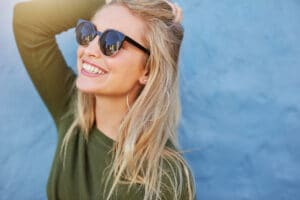
Follow my recommendations to protect yourself and your family from the damaging effects of sun exposure.
1. Limit sun exposure between 11am and 3pm. Mid-day sun is the strongest. Seek shade during these hours.
2. Wear a wide brimmed hat. You want to protect the back of your neck and your ears – so a baseball style cap is not the best.
3. Wear protective clothing. A light weight, long sleeved shirt and pants is ideal.
4. Wear sunglasses. Ultraviolet rays can damage the cornea on the surface of your eye, leading to early cataracts.
5. Wear sunscreen – every day, year round. Choose an SPF 30 or above, and look for the words “broad spectrum” or UVA/UVB on the label.
6. Use enough sunscreen. Did you know you should a teaspoon of sunscreen just for your face? You need 2 tablespoons of sunscreen to cover your entire body and face.
7. Reapply sunscreen correctly. Every 2 hours when outdoors. Reapply after swimming, towelling, and activities where you perspire heavily.
8. Remember that water, snow, sand, white concrete reflect the sun’s damaging rays. This increases your risk of sun damage.
9. Don’t forget to protect your ears, top of your feet, top of your head (including the part of your hair), and your lips. These areas are often forgotten, and easily sunburn.
10. You need sunscreen on cloudy days. 80% of the ultraviolet light penetrates through cloud cover.
11. Avoid tanning beds. The UVA light from tanning beds penetrates deeply, and increases your risk of both skin cancer and premature skin aging. It is a myth that the tan from a tanning bed protects you from a sunburn acquired outdoors.
12. If you like the look of tan, fake it. Use a self-tanner, spray tan or bronzer to get the golden glow you may desire. Your faux tan does not provide protection from UVL – in other words, you will still need to use sunscreen.
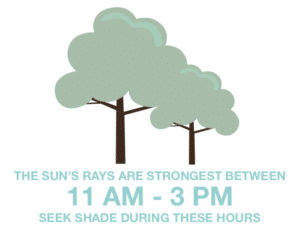
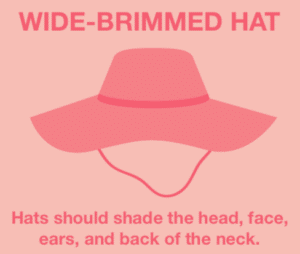
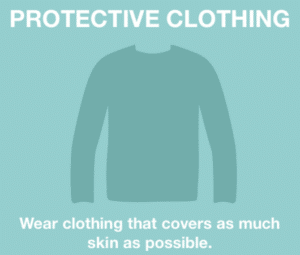
Infographics courtesy of AAD.org
What about babies?
It only takes one blistering sunburn to double your child’s risk of developing melanoma! So it is key to protect children’s skin when outdoors, and to instill good sun safety habits.
Babies have thinner skin, that is more sensitive to the sun. The immune response of a baby’s skin to sun exposure is not fully developed. And a baby’s skin surface to body weight ratio is higher than an adults, which means a baby absorbs more topically applied products.

~ Do not expose babies under age 1 year to direct sunlight. Babies should be kept shaded, under an umbrella or under the canopy of a stroller.
~ Do not use a chemical sunscreen until age 6 months
~ Dress your baby in loose fitting clothes which cover the arms and legs, and a wide brimmed hat
~ Chose to take walks early in the morning or late in the day, when the sun’s rays are less intense
~ Chose a mineral sunscreen, with SPF 30 or above, that is broad spectrum covering both UVA and UVB rays
Interactions with sun and some medications
Certain medications may make you more sensitive to the sun. The acne medications Accutane and Tetracycline are in this category, as are sulfa antibiotics, some diuretics (water pills), some anti-depressants and anti-psychotics, and certain diabetes pills. These drugs when combined with the sun may lead to sunburn, swelling, rash or even blisters. Read labels and the printed material your pharmacist provides when starting a new medication.
It’s never too late to start sun protection – a note to seniors
I frequently hear my senior citizen patients comment, that they grew up without sunscreen being available and they were not told about the dangers of excessive sun exposure and sunburns. My reply is just as it’s never too late to quit smoking cigarettes, it’s not too late to implement sun protection measures. You are never too old to wear a hat, seek shade and wear sunscreen.
What is the difference between UVA and UVB?
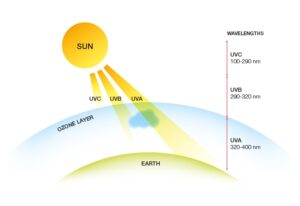
Ultraviolet B radiation, also known as UVB, is a shorter wavelength of sunlight, and causes a sunburn. It affects the upper layers of the skin and causes tanning and skin cancer also. You can why it is never safe to tan, as the wavelengths of light that creates a tan also causes skin cancer. Ultraviolet A radiation, or UVA, penetrates deeper into the skin than UVB. UVA causes premature aging, and skin cancer. In Canada, we get UVA year round; we are not exposed to UVB during the winter months.
What is the UV Index?
Environment Canada’s UV Index measures the intensity of burning rays (UVB) of the sun. The UV Index indicates what the peak intensity will be for a given day, and this is usually in the afternoon. The higher the UV Index number, the stronger the sun’s rays. In Canada, we measure our UV Index on a scale of 1 – 11. Radio and TV news typically broadcast the expected UV Index. By knowing the UV Index, you can plan your outdoors activities accordingly.
What to know about sunscreen
There are two types of sunscreen: physical sunscreen and chemical sunscreen. Physical sunscreen is often called mineral sunscreen as the active ingredients are zinc oxide and titanium dioxide. Think of a physical sunscreen as acting like a shield: the sun rays hit the mineral particles sitting on the surface of the skin, and they bounce off the shield. A physical sunscreen is a good choice if you have sensitive skin, for infants, or have a concern about chemicals used on the skin in general.
A chemical sunscreen works like a sponge: the chemicals absorb the ultraviolet rays and prevent them from penetrating deep in the skin. These are often easier to rub into the skin without leaving a white residue. Chemical sunscreen comes in a greater variety of styles: sprays, sticks, lotions and gels. Many chemical sunscreens also contain zinc oxide and titanium dioxide.
I recommend you chose an SPF 30 or greater. Look for the words “broad spectrum” or “UVA/UVB” on the label. If you are wearing your sunscreen for an outdoor activity, look for water resistant or sweat proof on the label.
Did you know that the SPF label is only a measure of the UVB protection? SPF = sun protection factor, but it actually is a measure of the ability of the sunscreen to protect you from burning in the sun. It is UVB rays which cause sunburn. I like to to think of SPF = sunburn protection factor. In Canada, we do not currently have a measure of UVA protection. This is why I want you to chose a sunscreen marked UVA/UVB or broad spectrum.
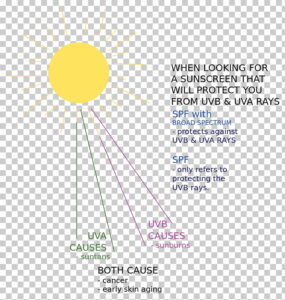
No sunscreen can block 100% of the sun’s damaging ultraviolet rays. In other words, there is no “total block” available in a sunscreen. When applied correctly:
~ an SPF 15 filters 93% of the UVB rays from sun light
~ an SPF 30 filters 97% of the UVB rays from sun light
The key is “when applied correctly”. If you are not applying the correct amount, if you are not reapplying as required, or if you are using expired sunscreen you will not achieve the maximum degree of protection.
Sunscreen had some negative press in the past year, and this caused a lot of anxiety about the safety of using sunscreen. The U.S.A. Food and Drug Administration (FDA) proclaimed it will require updated regulatory requirements for sunscreens sold in the USA. Canada is likely to follow suit. A sunscreen is classified as an over-the-counter drug. A sunscreen has a Drug Identification Number when sold in Canada. Sunscreen is classified as a drug because it can:
- Prevent sunburn
- Reduce skin cancer
- Decrease premature aging
The FDA is looking for more safety data on the extent of absorption of chemicals found in sunscreen through the skin into the human body, and if absorption of sunscreen ingredients has any effect on your skin or body. The FDA did NOT tell the public to stop using sunscreen. If you have concerns based on the FDA’s inquiry, I suggest you opt for a physical sunscreen.
What about Vitamin D, the sunshine vitamin?
It is true that UVB rays from the sun trigger Vitamin D production in the skin. However we can obtain the required amounts of Vitamin D from foods such as salmon, tuna and eggs and in fortified foods such as milk, yoghurt and orange juice. In Canada, we need supplemental Vitamin D over the winter months, when we don’t receive UVB rays from the sun. Our grandparents knew this, and took cod liver oil as a vitamin D supplement. My recommendation is to continue practicing safe sun, wear your sunscreen, and if you don’t/can’t eat dairy foods, take a Vitamin D supplement.
What is photoaging?
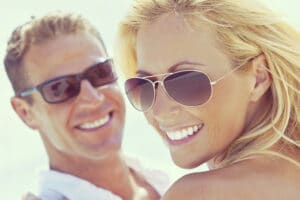
There are multiple things that cause skin aging. It can be broadly divided into two categories. Intrinsic aging is determined by our genetics. Our ancestry can’t be changed, thus we can’t modify intrinsic aging.
Extrinsic aging is caused by the environment and our lifestyle. We can greatly influence this type of skin aging. The sun is the number one environmental risk factor for extrinsic skin aging. We call this damage photoaging. The harmful ultraviolet rays from the sun causes thinning of the skin, brown spots and blotches, ruddy complexion, broken capillaries and lines and wrinkles. So if you want to prevent unnecessary sun induced aging you need to protect your skin. Seek shade, cover up with clothing, and use sunscreen SPF 30 or greater.
Spending too much time outdoors without proper protection from the sun’s harmful UVL can add years to your appearance. We can help! We offer multiple treatments that can reduce some signs of sun damage that are making you look older. As a board certified dermatologist, I will recommend a personalized treatment program: the right products and treatments, in the correct amount, in the proper order. Reducing the signs of sun damaged skin is a focus of our clinic.
We look forward to helping you!

